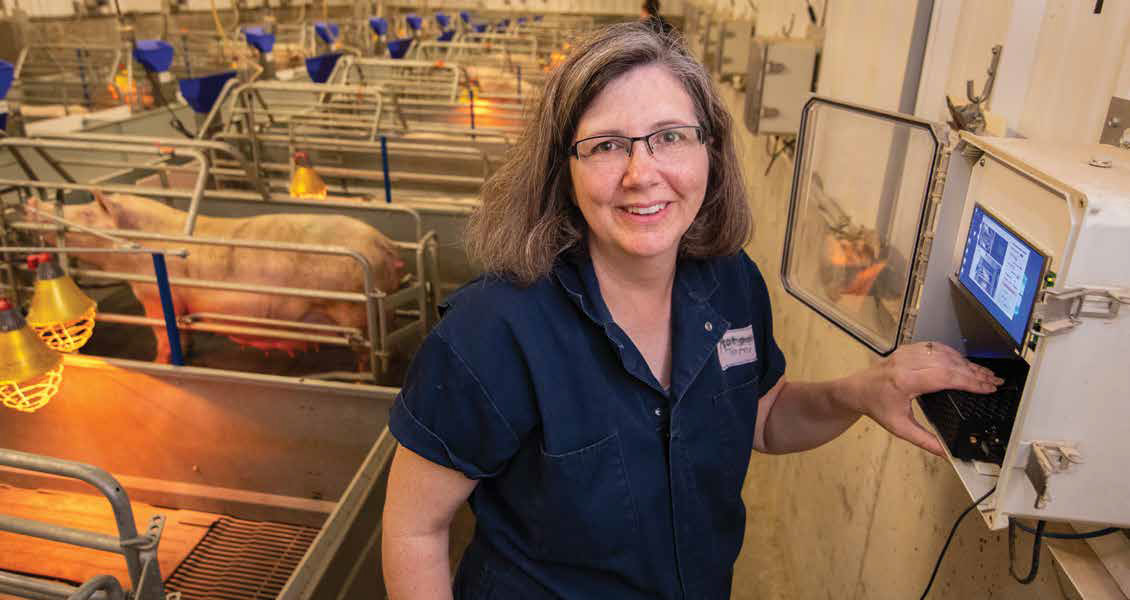
Precision AnimalManagement: Changing the Way Producers Use Technology
A Vision for the Future

Technology has not only changed the livestock industry, but also brought important changes to traditional agriculture. Tami Brown-Brandl, professor in the Department of Biological Systems Engineering at the University of Nebraska–Lincoln, uses an engineering approach to research ways technology can improve production agriculture. Her work is termed “precision animal management” and according to Brown-Brandl, Nebraska leads the United States in this work.
Precision animal management, sometimes referred to as precision livestock farming, is defined by Brown-Brandl as gathering live data on individual animals within a production system through technology. This technology helps producers quickly understand animals.
“Part of precision animal management is that we must create a vision for the future,” Brown-Brandl said. “We have to know how and when to use the technology to keep farming resilient.”
Brown-Brandl said livestock producers can use precision animal management to be more efficient with time. She suggested specific, cost-friendly technologies for producers to use such as a smart phone app focused on identifying heat stress, depth imaging cameras and RFID tags.
Heat Stress App
Technology is an important component to combat heat stress in livestock. Heat stress occurs when an animal absorbs too much heat, which causes stress, illness or even death, according to Brown-Brandl. When a heat wave (high temperatures for over seven consecutive days) hits, producers have to work to keep livestock alive.
Brown-Brandl said when livestock are exposed to heat stress, feed intake, respiration rate and body temperature all are affected. At times, heat stress can even cause death due to higher internal temperatures. To combat this, shade or a sprinkler system is needed to protect the livestock. Brown-Brandl said that it is important for producers to know when the next heat wave is expected, so facilities are properly equipped to handle hot temperatures.
Brown-Brandl, United States Department of Agriculture and Hollman Media released a heat stress app in April 2015. Using data from the National Weather Service, a map allows producers to pinpoint the location of their feedlot. This app then allows producers to anticipate an impending heat stress event and be prepared to keep their livestock cooler and stress levels low. Producers can find this app in the Google Play store or Apple Store by searching the term “heat stress.” The image for the app is the graphic below.
(Graphic of the Heat stress App here)
Depth Imaging Technology
Depth imaging technology has helped producers in the pork industry. According to Brown-Brandl, when taking a photo, depth imaging cameras use distance, instead of color, to capture the frame.
Brown-Brandl and others are working on projects using depth imaging technology with the goal of finding better ways to determine specifics of each animal. For example, depth imaging technology can help identify the weight of each animal, whether an animal is in the correct condition — not too fat nor too thin — or if an animal is lame (unable maintain a normal stance). Brown-Brandl said that depth imaging technology allows producers to identify animals that need attention more easily and more quickly in a large group.
Depth imaging technology is also used to help create farrowing crates. Brown-Brandl described a farrowing crate as a metal enclosure used for housing a sow and her newborn litter of piglets. For the health of the animals, it is critical to create farrowing crates large enough for the sow and her piglets. She said that depth imaging cameras can help determine the best design for a farrowing crate.
Radio-Frequency Identification Tags
Precision animal managment also uses RFID tags to identify animals in a producer’s herd. According to Brown-Brandl, an RFID tag is a radio-frequency identification system that uses electromagnetic fields to automatically identify and track tags attached to objects. The tags contain electronically stored individual numbers that can be used to identify animals or objects.
Brown-Brandl said an animal’s feeding behavior can be tracked through RFID tag identification placed in an animal’s ear. Data is captured when an animal is feeding. This system allows the producer to know how much time each individual animal spends at the feed bunk.
RFID tag technology offers a great deal of information to many. Brown-Brandl said that this information can be used to detect illness on an individual animal basis. In addition, this information can help engineers understand the animal dynamics within the animal space so they can design better pens. This information can also be used by geneticist to help select animals that have better characteristics such as better heat tolerance.
“The RFID tags are the eyes and the ears of the producers and the barn 24/7, 365 days a year. They help producers make sure all animals are eating. We can look at the data and see how much animals ate yesterday and predict what they should eat today,” Brown-Brandl said.
With this technology, producers can monitor each animal. For example, if there is a decrease in feed intake, they can identify that animal more quickly and treat the problem.
Advancing Career Opportunities in Farming
Precision animal management allows qualified recent graduates to explore new career opportunities in the agricultural industry. Brown-Brandl said careers in computer science, animal science, agricultural engineering and mechanized systems management are just a few examples of careers that can impact the agricultural industry with precision livestock technology.
Brown-Brandl said these career opportunities are a great option for those not wanting work in traditional agriculture, but may want to return to a farm. Others that have no background in agriculture can also use this career opportunity to be a part of an emerging technology area and a driving workforce, while enhancing the future of precision animal management.
Producers will not be replaced when adding new technology to their farm, but rather, technology could increase profits for operations. Animal agriculture will not only be able to remain resilient by attracting new workers into the field, but also allow producers to manage their time efficiently while being more productive.